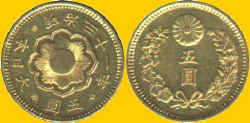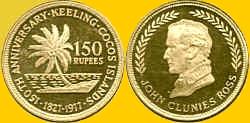This is the Worldwide Numismatics Website!
This is a modest collection of second millennium gold coins
Click the thumbnail picture to see a larger version of the picture, then use your browser BACK button to return to the original page you were viewing.
JAPAN
Japan's earliest settlers came by land bridges from Korea to the west and Siberia to the north (the latter are believed be Ainus who still live on Hokkaido) . .By AD 300, the Yamato kingdom had loosely unified the nation through conquest and alliance. The samurai used arms to defend its autonomy and many different families controlled Japan over the years. Minamoto Yoritomo assumed the rank of shogun in Kamakura, while the emperor remained the nominal ruler in Kyoto. This was the beginning of a long period of feudal rule by successive samurai families which lingered until imperial power was restored in 1868. In 1867 the ruling shogun, Keiki, resigned and Emperor Meiji assumed control of the state,who led Japan in westernisation and industrialisation. In 1889 Japan created a Western-style constitution. Japan was defeated in World War II and the Allies under U.S. General Douglas MacArthur rewrote Japan's constitution prohibiting any militaristic actions by the state.
Coinage was minted in various cities in Japan including the Ryukyu Islands into the 19th century. During the late 19th and early 20th century, mints operated in both Osaka and Tokyo,
5 Yen - 1898
KM-032
- 4,17 g
Mintage - 0,055M
The obverse of this coin features a stylized radiating sun. The country's name is to the left, the denomination is at the bottom, and the year (Meiji Year 31) is to the right. The reverse features the denomination in the centre surrounded by a wreath. The Japanese imperial chrysanthemum is at the top.
If you would like to view more Japanese gold coins, click Page Japan 1
JERSEY (BAILIWICK)
Jersey is one of the Channel Islands off the northwest coast of France. The Normans made the greatest impact on the Channel Islands when they were annexed to the Duchy of Normandy in the 10th Century. When William the Conqueror gained the English crown in 1066 the Channel Islands became part of the Anglo-Norman realm. In 1204 King John lost Normandy to the French and the islanders chose to remain loyal to the English crown. They were granted rights and privileges which to this day are not subject to the British Parliament but only to the Queen in council. The constitutional relationship with the UK is the product of 900 years of custom and usage and is not affected by changes of government in the UK. This relationship has been confirmed by Royal Charters which over the centuries secured the independence of the Island's judicial system from the English courts and granted important privileges including freedom from UK taxes.
Jersey coinage was minted in England.
£
25 - 1972
KM-042
- 11,90 g
Edge - Reeded
Mintage - 8.500
This NCLT "coin" was issued in 1972
to celebrate the 25th anniversary of the marriage of Queen Elizabeth II (b1926-)
and Prince Consort Philip (b1921-). The obverse features a tiaraed bust of the
Queen surrounded by the legend QUEEN ELIZABETH THE SECOND - SILVER WEDDING 1972.
The reverse has the Royal Arms of 1593 surrounded by the legend BAILIWICK OF
JERSEY - TWENTY FIVE POUNDS.
There are more Jersy gold coins in this section if you are interested - Page Jersey 1
JORDAN
The Kingdom of Jordan is steeped in history and had been a major site for civilization since the Palaeolithic Age. Archaeological evidence is constantly bringing to light signs of habitation from the dawn of history to the present day. In 331BC, Alexander the Great conquered the area introducing Hellenic culture to the area. Between 400BC and 160AD, the Nabataean civilisation flourished in the southern part of the Kingdom. with the capital at Petra. Jordan was part of the Roman Empire between 63 and 324AD. The Byzantine period, 324 to 632AD saw the inhabitants of Jordan providing crops and livestock from their farmlands to sustain travellers on the caravan routesthat linked China, India and southern Arabia with Egypt, Syria and the Mediterranean. 630AD marked the beginning of the Arab-Islamic era. The area was ruled for two centuries by the Umayyad and Abbasid dynasties of Baghdad and Damascus. In 1099 AD, the Crusaders arrived in Jerusalem. In 1187, Saladin defeated the Crusaders at Kerek, thus leading to their complete withdrawal from the Near East. A 300-year rule by the Mamelukes followed, after which Jordan became part of the Ottoman Empire. This period came to an end with the famous Arab Revolt, between 1915 and 1918. In 1921, Emir Abdullah established the Emirate of Trans-Jordan as a self-governing territory under British mandate. In May 1946, Emir Abdullah was proclaimed King of the independent Hashemite Kingdom of Jordan. The formal union of Jordan and the West Bank was declared in 1950.
Mints were located in various cities in modern-day Jordan as early as the days of Alexander the Great.
25 Dinars - 1977
KM-033
- 15,00 g
Edge - Reeded
Mintage - 4.724
This NCLT "coin" was issued in 1977 to celebrate the 25th anniversary of the accession of King Hussein I (b1935-d1999) to the throne of the Hashemite Kingdom of Jordan. The obverse shows a bust of the King with an Arabic legend at the bottom. The reverse has the Royal Arms of the Kingdom. The country's name in English is displayed at the top with the event below. The arms have the dates 1852-1077 at the bottom. The denomination 25 DINARS in English and Arabic are at the very bottom.
KATANGA (Breakaway Congo Province)
Katanga, a mineral rich area in the eastern Congo broke away from the Congo shortly after Belgium granted it independence because the new government was led by a communist dupe, Patrice Lumumba. Lumumba used terror to subdue his democratic opposition. As a result, Katanga under its Christian and pro-western president, Moise Tshombe, announced that "we are seceding from chaos." Tshombe asked Belgium to send military officers to recruit and train a Katangese army to restore order in Katanga. Instead Lumumba asked for and got the aid of United Nations "peacekeepers" to force Katanga back under Congolese rule. It took two years of UN warmaking by its "peacekeeping forces" to accomplish this goal. UN troops from Ireland, Sweden, Italy, Ethiopia, and India were transported to Katanga by the US Air Force. According to numerous eyewitness accounts, the troops of the UN's Operation Morthor carried on one of the most brutal military campaigns of our century. The UN troops bombed, machine-gunned, and looted civilian targets: hospitals, ambulances, churches, schools, and homes. Congolese troops were supplied and transported by the UN to invade Katanga from the north. Reports of cannibalism, massacre of missionaries and other civilians, and other atrocities were rife. The passage of these UN allies left in its wake complete anarchy in place of the peace and prosperity that had formerly prevailed in that region. Katanga was forcibly reunited with the Congo. The Congo has had a turbulent history under successive, despotic governments.
Katanga only issued three coins that were minted in Europe.
5 Francs - 1961
KM-002a - 13,33 g
Mintage
- 0,020M
This interesting piece was issued by Katanga, a
breakaway province of the Congo after it was granted independence by Belgium.
The Congo at the time was under the control of a communist lackey Patrice
Lumumba who was actively anti-western. Katanga's
chief of state was Moises Tshombe, a pro-western leader who was finally
overthrown by the central government. Katanga
being a mineral-rich province was a true prize.
The obverse has the country's name with a central picture of bananas.
Below it are two Baluba crosses which were an early form of money in that
area. The reverse features a Baluba
cross with the French legend NATIONAL BANK, the denomination, and the date.
Katanga struck two circulation coins, a 1 France and a 5 Franc piece in
bronze. This coin is a gold version
of that 5 Franc piece.
KEELING-COCOS ISLANDS
Although the Cocos (Keeling) Islands were discovered in 1609, they were not inhabited until 1826, when an Englishman, Alexander Hare, established a settlement on the main atoll. The next year Captain John Clunies-Ross, a Scottish seaman and former employee of Hare, settled on another of the islands of the atoll. In 1857 Captain Fremantle of HMS Juno formally declared the Islands part of the British Dominions. In 1886 Queen Victoria granted all the islands to John Clunies-Ross' grandson George and his heirs, reserving powers to the Crown to resume land for public purposes and to conduct cable communications. In 1955 the Islands, which had been governed through the British colonies of Ceylon, the Straits Settlements and Singapore, were accepted as a Territory of Australia. In 1978 the Australian Government purchased from Mr Clunies-Ross, his property interests in the islands, other than his family home (Oceania House) and surrounding grounds on Home Island (approximately 5 hectares in total). In 1979 ownership of the village area of Home Island was transferred to the Cocos (Keeling) Islands Council, the local governing body elected by the Home Island community, to be held in trust for the residents. In 1984 the remainder of the land within the Islands, apart from land owned by the Commonwealth and Mr Clunies-Ross, was transferred by trust to the Council on behalf of the Islander community. In 1993 the Commonwealth purchased the remaining property of Mr Clunies-Ross, known as Lot 14, on Home Island. On 6 April 1984 the Cocos community, in a United Nations supervised Act of Self Determination, voted overwhelmingly to integrate with Australia.
150
Rupees - 1977
KM-010a
- 8,48 g
Edge - Reeded
Mintage - 2.000
This NCLT "coin" was issued to honor the 150th anniversary of the Clunies-Ross family who owned these islands until they were purchased by Australia in 19. The obverse has a depiction of an islet with a palm tree. The legend 150TH ANNIVERSARY- KEELING - COCOS ISLANDS - 1827-1977 encircles the image. The reverse has a bust of John Clunies-Ross (b1786-d1854) who founded the copra plantation on the islands and populated them with workers. His name is at the bottom.
If you would like to see additional gold coins, please click here - Page 19
If you want to return to the home page, please click here - Home

